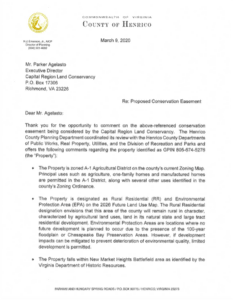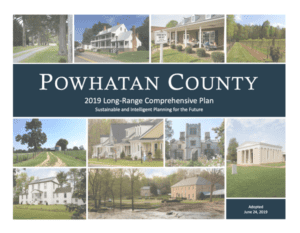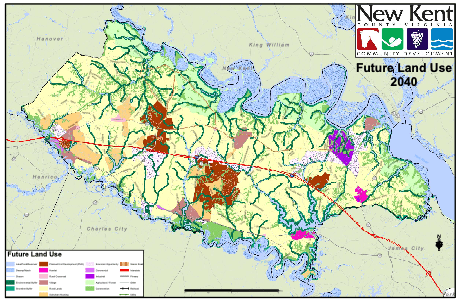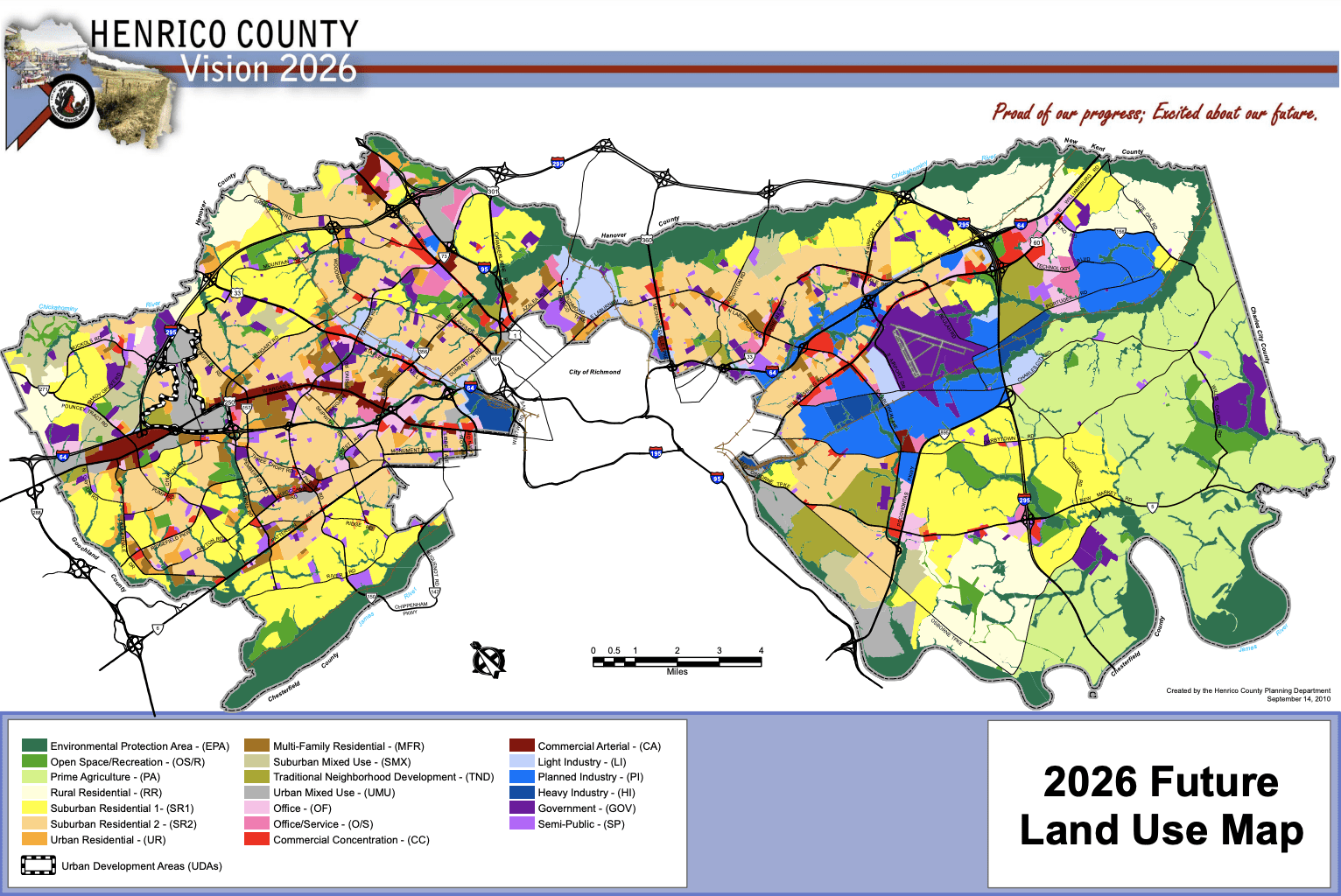If you are interested in land conservation or conserving your own land, engaging in your county’s comprehensive plan update is a great way to get involved.
When a landowner asks us about placing their property under a conservation easement with Capital Region Land Conservancy, we have to first find out whether a conservation easement would conform to the local comprehensive plan. Of course, we evaluate the conservation values of the land, whether it has prime agricultural soils, ecological habitat, historic resources, scenic and open space benefits. However, in a region like Richmond that has urban, suburban, and rural communities we must also assess the comprehensive plan and engage planning directors at the county or city level.
We do this not only in respect of our partnership with localities but because the Code of Virginia also requires it. Unlike most states across the nation, Virginia law directs that all conservation easements must conform with the local comprehensive plan.
There are two provisions that authorize the protection of land: the Open-Space Land Act and the Virginia Conservation Easement Act. The first is applicable to public bodies while the latter applies to qualified non-profits like Capital Region Land Conservancy. In instances where CRLC co-holds an easement with a public body like the Henricopolis Soil & Water Conservation District, both provisions apply equally. Title 10 of the Code of Virginia notes distinctions between the two programs. The Open-Space Land Act (§10.1-1701) states “open-space land shall conform to the official comprehensive plan for the area in which the property is located.” The Conservation Easement Act (§10.1-1010) is even more definite in stating “No conservation easement shall be valid and enforceable unless the limitations or obligations created thereby conform in all respects to the comprehensive plan at the time the easement is granted for the area in which the real property is located.”
 It is the validity of the conservation easement that CRLC is concerned with as we must protect our authority and the intentions of the landowner who may have donated the conservation easement. The additional language citing “limitations or obligations” within the conservation easement that must conform “in all respects” to the comprehensive plan has led CRLC to establish a practice to obtain a letter from the local planning director affirming such conformance. This letter is kept on file and recorded as an exhibit with the conservation easement to avoid later dispute if issues arise. This is best practice for accredited land trusts and is also standard procedure for easements held by state agencies like the Virginia Department of Forestry, Virginia Department of Conservation & Recreation, and Virginia Outdoors Foundation.
It is the validity of the conservation easement that CRLC is concerned with as we must protect our authority and the intentions of the landowner who may have donated the conservation easement. The additional language citing “limitations or obligations” within the conservation easement that must conform “in all respects” to the comprehensive plan has led CRLC to establish a practice to obtain a letter from the local planning director affirming such conformance. This letter is kept on file and recorded as an exhibit with the conservation easement to avoid later dispute if issues arise. This is best practice for accredited land trusts and is also standard procedure for easements held by state agencies like the Virginia Department of Forestry, Virginia Department of Conservation & Recreation, and Virginia Outdoors Foundation.
For this reason, CRLC encourages supporters of land conservation and all citizens to engage in their local comprehensive plan updates. Understand your locality’s long-range goals.
 By Virginia law, each locality is required to not only have a comprehensive plan but to review it every 5 years. Code of Virginia §15.2-2223 outlines the scope and purpose of comprehensive plans with regard to the physical development of the territory within a jurisdiction. The comprehensive plan “shall be made with the purpose of guiding and accomplishing a coordinated, adjusted and harmonious development of the territory which will, in accordance with present and probable future needs and resources, best promote the health, safety, morals, order, convenience, prosperity and general welfare of the inhabitants, including the elderly and persons with disabilities.” This requirement allows localities great flexibility to establish subjective criteria for how it will guide its future. The law therefore provides further counsel to use “maps, plats, charts, and descriptive matter” that include “designation of areas for various types of public and private development and use, such as different kinds of residential, including age-restricted, housing; business; industrial; agricultural; mineral resources; conservation; active and passive recreation; public service; flood plain and drainage; and other areas.”
By Virginia law, each locality is required to not only have a comprehensive plan but to review it every 5 years. Code of Virginia §15.2-2223 outlines the scope and purpose of comprehensive plans with regard to the physical development of the territory within a jurisdiction. The comprehensive plan “shall be made with the purpose of guiding and accomplishing a coordinated, adjusted and harmonious development of the territory which will, in accordance with present and probable future needs and resources, best promote the health, safety, morals, order, convenience, prosperity and general welfare of the inhabitants, including the elderly and persons with disabilities.” This requirement allows localities great flexibility to establish subjective criteria for how it will guide its future. The law therefore provides further counsel to use “maps, plats, charts, and descriptive matter” that include “designation of areas for various types of public and private development and use, such as different kinds of residential, including age-restricted, housing; business; industrial; agricultural; mineral resources; conservation; active and passive recreation; public service; flood plain and drainage; and other areas.”

With conservation being noted as a possible designation within the comprehensive plan, many localities specifically call out their conservation objectives or map designated conservation areas. Some articulate historic preservation goals, agricultural and forestal districts, or areas for future parks and recreation. Others do not. It takes citizens to make their priorities known and provide input to make certain such items are included in any amendment or update to the comprehensive plan in their locality. Citizen groups have formed precisely around such purposes for example Route 5 Corridor Coalition, Henrico Conservation Action Network, Coalition for Hanover’s Future, Concerned Citizens of Charles City County, Partnership for Smarter Growth, and others.
CRLC’s new website has a resource library where we provide the future land use maps for each locality in our service area as well as their comprehensive plan and other maps and plans. You can also stay informed by visiting the planning department webpages for your locality: Charles City County, Chesterfield County, Goochland County, Hanover County, Henrico County, New Kent County, Powhatan County, and City of Richmond.

Some have helpful story maps to make it easy to understand the plan and see comparisons of previous land use maps with their newer version. Other localities have created dedicated websites for their comprehensive planning process such as two that are currently underway in Hanover (www.envisionhanover.com) and Henrico (www.henriconext.us).
For those interested in participating in the update to the Henrico County comprehensive plan the first workshop will be held on March 23 at 6:30 pm in the Henrico County Board Room located at 4301 E. Parham Road, Henrico VA 23228. The Community Visioning Workshop will include activities to help shape the goals for the future of Henrico County over the next 20+ years. Public input will provide the foundation for new issues and opportunities that should be addressed as well as develop an actionable implementation strategy to achieve the vision.
For those interested in participating in the update to the Hanover County comprehensive plan, here is a link to stay informed at Envision Hanover.

Parker Agelasto
CRLC Executive Director

